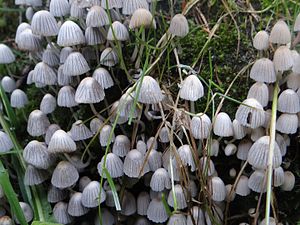Sown Tintling
| Sown Tintling | ||||||||||||
|---|---|---|---|---|---|---|---|---|---|---|---|---|

Seeded Tintling ( Coprinellus disseminatus ) |
||||||||||||
| Systematics | ||||||||||||
|
||||||||||||
| Scientific name | ||||||||||||
| Coprinellus disseminatus | ||||||||||||
| ( Pers. ) JE long |
The sown tintling ( Coprinellus disseminatus , Syn. Coprinus disseminatus ) is an inedible type of mushroom from the family of the Mürbling relatives (Psathyrellaceae). The saprobiont is widespread in Central Europe and can be found in large numbers on deadwood in forests, gardens and parks from May to October.
features
Macroscopic features
The hat of the sown tintling is 0.5–1.2 cm wide. It is initially ovate and obtuse, later bell-shaped and spread out. He only shields himself a little. The surface is grooved radially. The hat is initially cream-colored to whitish and covered with fine, fibrous velum. Later he is bald and tinged gray. The disc or the top of the hat remains ocher throughout. The hat does not melt with age. The first cream-gray, later dark-brown lamellae are attached to the stem and have a smooth white edge. There are lamellae between the lamellas . The spore powder is black in color. The fragile glassy stem measures up to 5 cm in length and up to 1.5, sometimes 2 mm, in width. It is colored white and initially a little powdered. The smell is insignificant.
Microscopic features
The smooth, elliptical spores are 7–10 µm long and 4–5 µm wide and have a distinct, centrally located germ pore. The top layer of the hat is hymeniform and has partially encrusted cells. In between there are up to 200 µm long, narrow cylindrical pileocystidia as well as hyphae-like or chain-like strands.
Species delimitation
The dwarf fibrous lobster ( Psathyrella pygmaea ), which can grow together with the sown ink lily, has a more brownish, less strongly grooved hat, narrower lamellae and a slightly bitter taste. The two types can certainly be distinguished microscopically: In contrast to the sown Tintling, the dwarf fibrous lump has utriform cheilocystidia with apical crystals .
ecology
The sown Tintling occurs primarily in deciduous forests. These are mainly beech forests, but also oak and hornbeam forests as well as riparian forests with alders and field elms . It grows less often in coniferous forests, there mostly on interspersed deciduous trees.
The fungus grows as a saprobiont on rotten stumps in the late optimal to final phase. It can also be found on buried wood or roots and sometimes on built-in wood or wood chips. Mostly hardwood is settled, rarely coniferous wood. The fruiting bodies appear gregarious to raspy, often in the hundreds. They are formed from spring to autumn.
distribution
The sown Tintling is widespread as a cosmopolitan in North America (eastern USA, Canada, Hawaii islands) and South America (Venezuela, Trinidad) as well as Europe, Asia ( Asia Minor , Caucasus , Japan) and Australia. In Europe, the area extends from Great Britain, the Benelux countries and France in the west to Estonia, Poland, Hungary and Russia ( Bashkortostan ), south to Spain, Corsica and Italy and north to Fennoscandinavia . In Germany the species is common everywhere.
swell
literature
- German Josef Krieglsteiner , Andreas Gminder (Hrsg.): Die Großpilze Baden-Württemberg . Volume 5: Mushrooms. Agarics III. Ulmer, Stuttgart 2010, ISBN 978-3-8001-3572-1 .
- Hans E. Laux: The great cosmos mushroom guide. All edible mushrooms with their poisonous doppelgangers . Kosmos, Stuttgart 2001, ISBN 3-440-08457-4 .
Individual evidence
- ↑ Andreas Melzer: The seeded Irrling . In: The Tintling . tape 80 . Karin Monday, 2013, ISSN 1430-595X , p. 13-20 .
- ↑ Fredi Kasparek: Seeded Tintling - Coprinus Disseminated Gray 1821. (Pers 1,801th) Retrieved on 10 February 2013 .
Web links
- Coprinellus disseminatus (Pers.) JE Lange - Fairy Inkcap. In:First Nature. Retrieved November 19, 2013.
- Michael Kuo: Coprinellus disseminatus . In: MushroomExpert.Com. February 2008, accessed November 19, 2013 .
- Kees Uljé: Coprinus disseminatus . Page with photo, drawings and description. Retrieved November 19, 2013.
- Michael Wood, Fred Stevens: California Fungi - Coprinellus disseminatus . In: MykoWeb. Retrieved November 19, 2013 .
- Roger Phillips: Coprinus disseminatus . In: RogersMushrooms. Retrieved November 19, 2013 .

